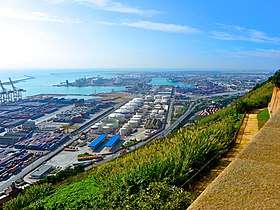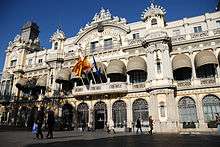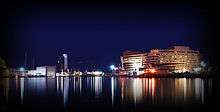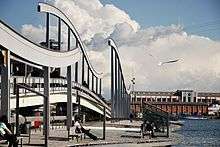Port of Barcelona
The Port of Barcelona (Catalan: Port de Barcelona, IPA: [ˈpɔɾ ðə βəɾsəˈlonə]; Spanish: Puerto de Barcelona) has a 2000-year history and great contemporary commercial importance as one of Europe's major ports in the Mediterranean, as well as being Catalonia's largest port, tying with Tarragona. It is also Spain's third and Europe's ninth largest container port, with a trade volume of 3.42 million TEUs in 2018.[4] The port is managed by the Port Authority of Barcelona. Its 7.86 km2 (3 sq mi) are divided into three zones: Port Vell (the Old Port), the commercial/industrial port, and the logistics port (Barcelona Free Port).
| Port of Barcelona | |
|---|---|
 | |
| Location | |
| Country | Spain |
| Location | Barcelona |
| Coordinates | 41°20′15″N 2°9′8″E |
| UN/LOCODE | ESBCN[1] |
| Details | |
| Operated by | Barcelona Port Authority |
| Owned by | Ports of the State |
| Land area | 10.653 square kilometres (1,065.3 ha)[2] |
| Statistics | |
| Vessel arrivals | 9,038 vessels (2018)[3] |
| Annual cargo tonnage | 67,756,258 tonnes (2018)[3] |
| Annual container volume | 3,422,978 TEUs (2018)[3] |
| Passenger traffic | 4,493,646 (2018)[3] |
This is not the only port in Barcelona, as there are also two additional yacht harbors/marinas: Port Olímpic and Port Fòrum Sant Adrià to the north.
Overview
The Port Vell area comprises two marinas or yacht harbors, a fishing port, a maritime station for ferries travelling to the Balearic Islands and other destinations in the Mediterranean and other stations or landing areas cruise ships, and it abuts the industrial port.
In the central area, it also houses "Maremagnum" (a shopping mall and nightlife complex), a multiplex cinema, the IMAX Port Vell (large-format cinema complex), and Europe's largest aquarium, containing 8,000 fish and 11 sharks in 22 basins filled with 6 million litres of sea water. Because it is located in a designated tourist zone, the Maremagnum is the only commercial mall in the city that can open on Sundays and public holidays. Next to the Maremagnum area are the "Golondrines", small ships that take tourists for a visit around the port area and beyond.
The Barcelona industrial port is to the south and comprises the Zona Franca, a tariff-free industrial park that has developed within the Port of Barcelona, across the flat land of the Llobregat Delta between the city of Barcelona and that of El Prat de Llobregat and the Barcelona International Airport to the south.
A good place to view both the industrial and pleasure port is from Montjuïc, and more specifically, from Montjuïc Castle, as well as from the aerial cable car connecting Barceloneta with the Ferry Station and Montjuïc.
Information

In common with much of Western Europe, the older traditional industries in Spain, such as textiles, declined in the face of foreign competition. The surviving companies closed their factories in the city or along the rivers, leaving industrial wastelands or abandoned workers' colonies. In many cases within Spain, these industries moved to the Zona Franca (Catalan: Polígon Industrial de la Zona Franca).
The free trade zone is located within the port area, not far away from downtown Barcelona, and is easy to access. It is 5 kilometres (3.1 mi) away from the Barcelona International Airport and connected via highway and railway.


Business investors here rent offices or bonded warehouses. They can also elect to purchase land to erect their own buildings.
The free trade zone offers a series of services. It is divided into a comprehensive service area, truck/lorry area, reception area, and sports facilities area. It has a customs duties service, bonded warehousing service, advanced telecommunication and computer system, security system, combined multiple transport system, and so on.
On 17 January 1977, a landing craft being used as a liberty boat by USS Trenton (LPD-14) and USS Guam (LPH-9), was run over by a freighter. The Mike8 boat capsized and came to rest against the fleet landing pier. Crew-members from both vessels were on hand to assist with rescue operations. There were over one hundred sailors and marines on board the landing craft. 49 sailors and marines were killed. A memorial is erected at the landing pier in memory.[5][6]
History
In 1978, the Ministry of Public Works declared Bilbao, Huelva and Valencia and Barcelona autonomous ports. It became then known as the Autonomous Port of Barcelona (Catalan: Port Autònom de Barcelona, Spanish: Puerto Autónomo de Barcelona) and while remaining a government body, it was able to function as a commercial enterprise subject to private law.[7]
Opening the Bosch i Alsina wharf in Port Vell (also known as the Moll de la Fusta) to the public in 1981 marked the start to transform the Northern part of the port.[8] This gained much momentum with the decision in 1986 that Barcelona would host the 1992 Summer Olympics. In the subsequent years, the run-down area of empty warehouses, railroad yards, and factories was converted to an attractive harborfront area in a huge urban renewal project. Also neighbouring Barceloneta and its beaches have been transformed to open the city up to the sea. During the Olympics the port hosted up to 11 cruise ships that served as floating hotels.[9]
In November 1992, the central body Ports of the State (Spanish: Puertos del Estado) was created by the Spanish government which brought the end to the Autonomous Port of Barcelona. Since then the port is operated by Barcelona Port Authority (Spanish: Autoridad Portuaria de Barcelona, Catalan: Autoritat Portuària de Barcelona, APB).[9]
The Logistics Activity Zone (Catalan: Zona d'Activitats Logístiques, Spanish: Zona de Actividades Logísticas, ZAL) is a multimodal transport centre that was set up in 1993 with an initial area of 68 hectares in the first phase. The second phase then saw an extension of 143 hectares into El Prat de Llobregat.[10][11]
In July 1999, the World Trade Center was opened.
Between 2001 and 2008 the port underwent an enlargement that doubled its size by diverting the mouth of the Llobregat River 2 km (1.2 mi) to the south and slightly pushing back the Llobregat Delta Nature Reserve.[12]
Passenger ferries
.jpg)
The three passenger terminals Terminal Drassanes, Terminal Ferry Barcelona and Grimaldi Terminal Barcelona are located in Port Vell.[13] While Baleària and Trasmediterránea operate connections to the Balearic Islands, the companies Grimaldi Lines and Grandi Navi Veloci serve destinations in Italy and Morocco.
| Destination | Terminal | Travel time | Ferry operator |
|---|---|---|---|
| Terminal Drassanes | 6h | Baleària[14] | |
| Terminal Port-Nou | 8h | Baleària[14] | |
| Terminal Ferry Barcelona | 8h | Trasmediterránea[15] | |
| Terminal Port-Nou | 9h | Baleària[16] | |
| Terminal Ferry Barcelona | 9h | Trasmediterránea[17] | |
| Terminal Ferry Barcelona | 9h | Trasmediterránea[18] | |
| Terminal Drassanes | 9h | Baleària[19] | |
| Grimaldi Terminal Barcelona | 12h 15m | Grimaldi Lines[20] | |
| Grimaldi Terminal Barcelona | 17h | Grimaldi Lines[21] | |
| Grimaldi Terminal Barcelona | 20h | Grimaldi Lines[22] | |
| Terminal Ferry Barcelona | 20h 30m | Grandi Navi Veloci[23] | |
| Grimaldi Terminal Barcelona | 28h | Grimaldi Lines[24] | |
| Terminal Ferry Barcelona | 28h 45m | Grandi Navi Veloci[23] | |
| Terminal Ferry Barcelona | 31h | Grandi Navi Veloci[23] |
See also
References
- "UNLOCODE (ES) - SPAIN". service.unece.org. Retrieved 28 April 2020.
- http://www.portdebarcelona.es/en/web/el-port/informacion-general
- Port of Barcelona traffic statistics 2018 - Port de Barcelona, 2019
- PortEconomics: Top15 container ports in Europe in 2018
- Remembrance held for shipmates 40 years after tragedy
- US Navy memorial commemorating the death of 49 marines (Port of Barcelona)
- "Port Barcelona - 1978-1980". www.portdebarcelona.cat. Port of Barcelona. Retrieved 29 January 2020.
- "Port Barcelona - 1981". www.portdebarcelona.cat. Port of Barcelona. Retrieved 29 January 2020.
- "Port Barcelona - 1992". www.portdebarcelona.cat. Port de Barcelona. Retrieved 1 February 2020.
- "A diversified port" (PDF). Port de Barcelona. Retrieved 29 January 2020.
- "Las ZAL, motores económicos de las ciudades". Interempresas (in Spanish). 25 February 2010. Retrieved 29 January 2020.
- "Port Barcelona - 1993-2007". www.portdebarcelona.cat. Port de Barcelona. Retrieved 1 February 2020.
- "Ferries". www.portdebarcelona.cat. Port Barcelona. Retrieved 1 February 2020.
- "Barcelona − Mallorca". Baleària. Retrieved 1 February 2020.
- "Barcelona − Mallorca (Palma)". Trasmediterránea. Retrieved 1 February 2020.
- "Barcelona − Ibiza". Baleària. Retrieved 1 February 2020.
- "Barcelona − Ibiza (Ciudad)". Trasmediterránea. Retrieved 1 February 2020.
- "Barcelona − Menorca (Mahón)". Trasmediterránea. Retrieved 1 February 2020.
- "Barcelona − Menorca". Baleària. Retrieved 1 February 2020.
- "Porto Torres − Barcelona". Grimaldi Lines. Retrieved 1 February 2020.
- "Savona − Barcelona". Grimaldi Lines. Retrieved 1 February 2020.
- "Civitavecchia − Barcelona". Grimaldi Lines. Retrieved 1 February 2020.
- "Barcelona ferries". Grandi Navi Veloci. Retrieved 1 February 2020.
- "Barcelona − Tangier". Grimaldi Lines. Retrieved 1 February 2020.
External links
| Wikimedia Commons has media related to Port of Barcelona. |
- Official website (in English, Catalan, French, and Spanish)